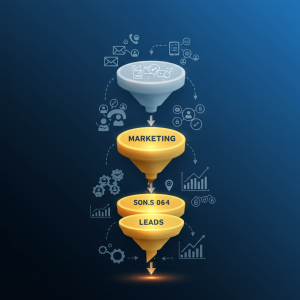Is Google Ads Outbound or Inbound?

If you’re involved in digital marketing, you’ve likely heard of Google Ads. This powerful advertising platform allows businesses to reach potential customers using targeted, highly effective online campaigns. But a common question that emerges is: Are Google Ads considered outbound or inbound marketing?
While Google Ads straddle boundaries and serve unique roles depending on their implementation, understanding their classification can help businesses create more intentional strategies. This blog will highlight what outbound and inbound marketing entail and answer the question of where Google Ads fits within these two categories. You’ll also gain valuable tips on leveraging Google Ads effectively in your marketing mix.
Outbound vs. Inbound Marketing: What’s the Difference?
Before classifying Google Ads, it’s essential to grasp the fundamental differences between outbound and inbound marketing. Each strategy allows businesses to connect with their target audience, but they differ in approach and execution.
What Is Outbound Marketing?
Outbound marketing is often referred to as “interruptive” marketing. This approach involves pushing your brand’s message out to potential customers, regardless of whether they expressed interest.
Some common examples include:
- Television and radio ads
- Display ads, including billboards
- Cold calling or emailing
- Direct mail campaigns
While outbound marketing can create widespread visibility, it can also be perceived as intrusive, particularly when the content reaches an uninterested audience.
What Is Inbound Marketing?
On the other hand, inbound marketing focuses on drawing potential customers in by creating and sharing content that’s valuable, relevant, and tailored to their needs. The goal is to educate, entertain, or solve problems so that prospects naturally find and engage with your brand.
Examples include:
- Blog posts and informative articles
- eBooks and whitepapers
- SEO-optimized website content
- Social media engagement
- Free tools, calculators, or templates
Inbound marketing prioritizes relationship-building and fostering trust with audience members on their terms, making it less interruptive than outbound tactics.
Where Does Google Ads Fit in the Marketing Spectrum?
Are Google Ads Outbound Marketing?
Google Ads, in certain contexts, aligns closely with outbound marketing characteristics. For example:
- Display Ads and YouTube Ads are served to users who may not have demonstrated explicit intent to engage with a product or service. These ads function similarly to traditional interruptive marketing tactics, aiming to capture attention even when users aren’t actively searching for solutions.
- Remarketing Campaigns, which target users based on previous site visits, also push messaging out to potential leads who may or may not be prepared to take action.
Are Google Ads Inbound Marketing?
Google Ads also has inherent traits that align with inbound marketing, especially with Search Ads. Here’s how:
- Search Campaigns leverage user intent by targeting individuals actively searching for specific products, services, or solutions. For instance, if someone searches “best coffee maker for small kitchens,” an ad for your compact coffee maker can appear right when they need it.
- Search Ads make it easier for potential customers to find and choose you over a competitor, which is a core characteristic of an inbound marketing strategy.
A Hybrid Approach
Ultimately, Google Ads exists in a unique space that overlaps outbound and inbound techniques.
Its categorization largely depends on implementation. Outbound strategies may rely heavily on pushing display ads to wider audiences, while inbound strategies can focus on search-based campaigns with high intent.
How Can You Leverage Google Ads Effectively?
Whether you lean toward an outbound or inbound approach, Google Ads offers flexibility to amplify your campaigns. Here’s how to make the most of it:
1. Identify Your Marketing Goal
Establish a clear objective before launching a campaign. Are you focused on brand awareness (often outbound), or are you targeting warm leads ready to convert (inbound)? Google Ads offers tools to help you align with these distinct goals.
2. Segment Your Audience
Use Google Ads’ robust data targeting to segment audiences by location, demographics, interests, or even past search behavior. This level of precision ensures that your outbound or inbound ads reach the ideal potential customers.
3. Optimize for Intent
If you’re adopting an inbound approach with search ads, emphasize keywords that align with high search intent. Tools like Google’s Keyword Planner help you find the right keywords to capture users actively seeking solutions.
4. Use Compelling Creatives
For display or video ads (outbound leaning tactics), focus on capturing attention quickly and conveying your message concisely. Incorporating eye-catching visuals and strong calls to action can improve click-through rates.
5. Leverage Conversion Tracking
Google Ads provides comprehensive analytics to track performance. Whether you’re driving awareness or conversions, robust key performance indicators will help you pivot and refine strategy over time.
Why Choose Google Ads in Your Marketing Strategy?
Whether used as an outbound powerhouse, as an inbound sales magnet, or as a blend of both, Google Ads is a game-changer for businesses that aim to connect with their audience online. Here are its key benefits:
- Global Reach and Precision Targeting allow marketers to engage tens of thousands (or millions) of relevant customers efficiently.
- Scalable Budgets support small businesses, even with tight ad-spend constraints.
- Measurable Results equip advertisers with actionable insights for real-time optimization.
- Customizable Campaign Types flex to fit diverse goals, from increasing brand awareness to driving sales.
Wrapping It Up
Is Google Ads outbound or inbound? The answer lies in how you use it. Search ads tend to align with inbound methodologies by targeting existing intent, while display and video ads lean more toward outbound marketing due to their interruptive nature.
The real magic of Google Ads lies in its flexibility. By combining both inbound and outbound strategies, businesses can reach new customers while also nurturing engaged prospects.
Ready to start optimizing your advertising campaigns? Whether you’re aiming to capture clicks or cultivate relationships, Google Ads offers unparalleled capabilities for both. Take the leap today and tap into this invaluable resource to drive growth for your business.





